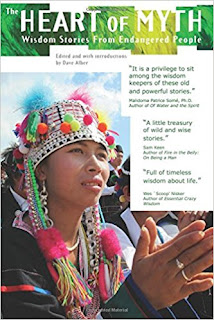WHAT IS MYTH FOR YOU?
"Myth, I discovered from
others… relates to poetry, trance states, shamanism, personal mythology, art,
history and more. There was no containing this thing — Myth — for long."
"Myths are transmissions of knowledge from the enlightened state, from cultures that rightly identify spiritual work with the routine moment-to-moment development of their awareness state. Myths are not quaint fantasy literature."
~Dave Alber, cultural mythologer
Hello
blogosphere!
I’m
Dave Alber, the guest blogger for September on Stephanie Pope’s Mythopoetry.com
blog.
About
me:
I’m
a friend of Stephanie, who, like her, is also alumni at Pacifica Graduate
Institute. We shared the same class, learning about the value of myth to such
diverse areas as psychology, literature, and filmmaking. At Pacifica, we
quickly became friends and have enjoyed many long conversations about the
poetics of myth in life. I enjoyed adding two essays to Stephanie’s Mythopoetry Scholar
e-zine (Guest
Rituals: The Aesthetics of Being With An “Other” and Myths and
Moon Cakes: The Cosmological Symbolism of the Zhou Revolution) and earlier
Stephanie web-hosted my poem To
the Dawn with images and an environmental context.
I’ve
also created a book about myth and art, Myth
& Medium, and have written a novel about personal mythology and
mythopoesis, Alien
Sex in Silicon Valley. More recently, I’ve published an anthology of world
myth that we’ll talk about shortly.
Despite
being somewhat tech-savvy in some areas, I’m a complete newbie to blogging, so
please forgive any errors in blogging etiquette. I am grateful to Stephanie for
— as always — encouraging
collaboration in mythic ventures.
I
would like to begin this blogging adventure with a memory. It is a moment of
surprise, fascination, and bewilderment.
I
had traveled from Georgia to California, had begun work as a graphic designer
in San Mateo, California, south of San Francisco, and was establishing a base
of stability from which to begin graduate school at Pacifica. Before the first
class, I drove down Highway 101 to Santa Barbara and camped on the beach. The
next morning, I would begin classes studying mythology. I was excited — filled with anticipation — because I was
an avid reader of myth as a child and a great fan of Joseph Campbell, whose
work struck me as an expanding revelation. I had, like many people, discovered
Campbell through his PBS series The Power
of Myth. And feeling touched in my heart by the enlivening force of his
words, I quickly devoured all of Campbell’s work that I could get my hands on: The Hero with a Thousand Faces, Transformation of Myths Through Time,
and the series that completely transformed my perception of world history, The Masks of God. I assumed — on my way to Pacifica’s welcome lecture to
new students — that most other students in Pacifica’s myth program would
have had a similar experience, yet in meeting students on the shuttle bus and on
Pacifica’s grounds, I quickly experienced confusion and befuddlement. In
hearing the stories of others, I was surprised and fascinated to hear from
everyone that I talked to that they had an experience that was very different from my own, and that
their own understanding of myth was again world’s apart from mine. We were all
fascinated by mythology, intent on the same object of study, like moths drawn
to a great and fascinating light… yet we were each approaching the subject in
the way of the Indian parable of the blind men and the elephant.
In
India, it is said, that there were once five blind men who had never
encountered an elephant before. Upon reaching the elephant, one blind man
touched the elephant’s ear. “Indeed, an elephant is like a fan,” he said. While
another blind man touched the elephant’s leg, “No, an elephant is like a tree,”
he replied to the first. Another touched the elephant’s trunk. “It is like a
snake.” Yet another touched its tail. “Almost. For I think it is more like a
rope.” Finally, the last touched the elephant’s side. “How can you say that?
For from my perception, an elephant is like a wall.”
Consequently,
one of my first lessons at Pacifica was that myth was a totality wholly other
than the expectations set by my own point of departure. In shared conversations
with others, our shared perception of myth seemed to swell, grow, and change
shape. We were not blind men after all… it seemed. We were — each of us — like Menelaus gripping
Proteus on the beach of the island of Pharos.
For
coming from Egypt to his homeland, Menelaus was detained on the island and
needed to grip Proteus — and hold him
fast — in order to progress. Yet when he gripped that old god of the sea,
Proteus changed shape… to a lion… to running water… to a tree… and so on,
transforming himself again and again within Menelaus’s grasp, until eventually, offering up truth.
In
studying myth, we each had gripped Proteus, and gained truth and truths from
the experience. And in traveling to Santa Barbara, each time, old Proteus would
wash ashore and greet us as teachers, mentors, friends, and fellow students.
Myth,
I discovered from others… relates to poetry, trance states, shamanism, personal
mythology, art, history and more. There was no containing this thing — Myth — for long. Once your griped it in
your hands and sat down for dinner with other students of mythology, you’d
realize that it had wiggled free of your grasp and had become something else
entirely.
Bradley
Olson recently posted an essay
on the importance of rethinking myth and personal definitions of myth, and
similarly, he referenced it back to the mystical function of myth.
I
had when writing Myth & Medium
one definition of myth, in Alien Sex in
Silicon Valley another, and most recently, in the anthology of world myth
that I had mentioned earlier, The
Heart of Myth, yet another definition of myth has emerged from the
great Ocean of the Streams of Stories that is myth’s protean nature: Myths are transmissions of knowledge from the enlightened state, from cultures that rightly identify spiritual work with the routine moment-to-moment development of their awareness state. Myths are not quaint fantasy literature. Rather, they communicate in symbolic language the play of eternal values into the field of time. Myths are so designed as to break the “individual” open to a totalizing identification with eternity.
 |
| The Heart of Myth: Wisdom Stories From Endangered Peoples, Dave Alber |
Already,
the definition pulses within our grasp. It is imperfect and limited. It is
intentionally imperfect and limited.
Why?
The Heart of Myth is an attempt — through
context and examples of myth from around the world — to unpack myth… as a communicational medium grounded in
profound states of awareness.
Arguments
centering upon myth and ritual (after van Gennep) often ponder, “Which
came first, the myth or the ritual?” My argument in The Heart of Myth is that state
of awareness is primary. Like poetry, myth is a mode of communication with
shifting sets of grammatical characteristics based, nevertheless, upon core
principles of metaphor and figurative language. Unpacked section at a time… The Heart of Myth is an attempt to share
with a wider audience the grammar of myth as a system for the transmission of
profound states of awareness.
If Campbell’s The Hero
with a Thousand Faces was Campbell’s attempt to teach people how to read a
myth, then The Heart of Myth is my
attempt to unpack the grammar of the mystical function of myth.
To
this end, in the next blog… we will take our first steps in our discovery — inward, ever inward — toward that
foundational state of awareness from which myth emerges.
ABOUT THE AUTHOR
Dave
Alber is the author of To
the Dawn, Myth
& Medium, and Alien
Sex in Silicon Valley. His book The
Heart of Myth is a global anthology of living myth that unpacks the
grammar of world mythology. His website is DaveAlber.com
and his English learning products are at EasyAmericanAccent.com.
DAVE ALBER September Guest Blogs
Blog1
What Is Myth For You?
Blog 2
What Is The Core Grammar of Mythology?
Blog 3
What Is The Alchemy Of Myth?
Blog 4
What Is The Ecological Vision Of Myth?
Blog 5
The Myths Of Native North America
Blog 6
The Myths Of The Crow (Apsaalooke) People
What Is Myth For You?
Blog 2
What Is The Core Grammar of Mythology?
Blog 3
What Is The Alchemy Of Myth?
Blog 4
What Is The Ecological Vision Of Myth?
Blog 5
The Myths Of Native North America
Blog 6
The Myths Of The Crow (Apsaalooke) People









